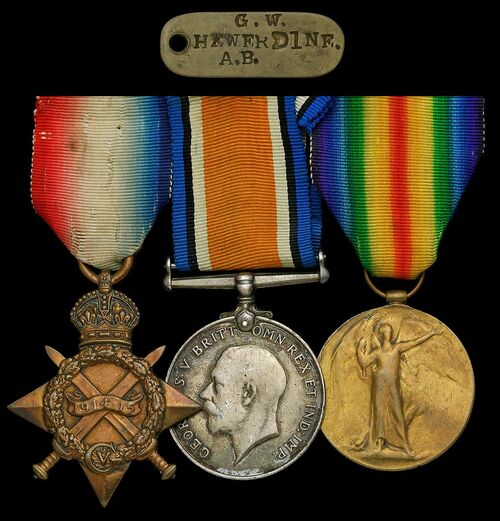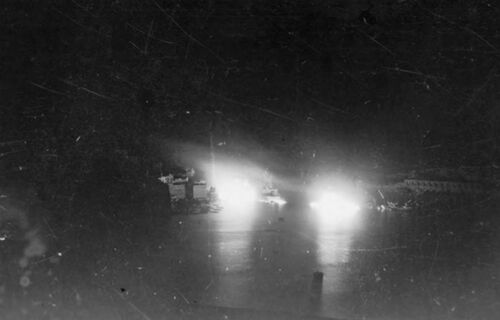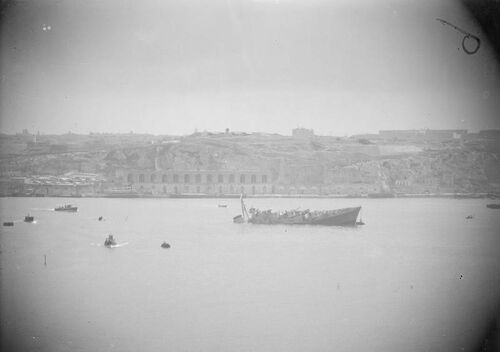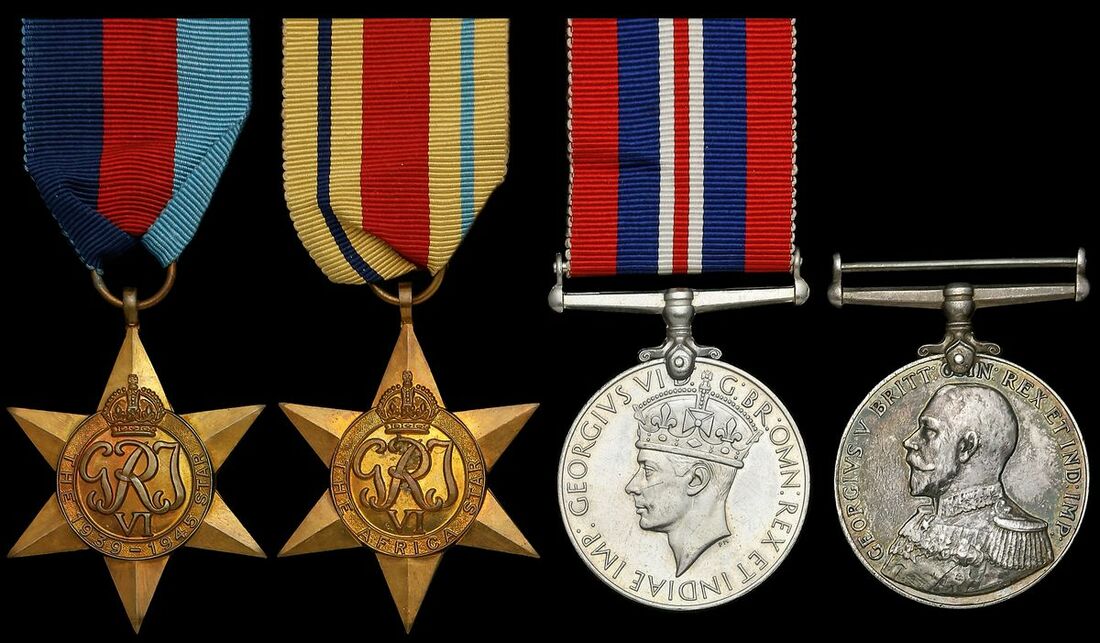Auction: 23112 - Orders, Decorations and Medals - e-Auction
Lot: 461
'The attack took Maori by surprise, no ships or shore-batteries having engaged the raiders, with the result that nearly all officers and ratings were asleep. The explosion opened the bulkhead between the engine room and the gearing room. Lubricating oil in the gearing room, about 2,000 gallons, caught fire. Oil fuel from one of the tanks later added to the blaze. The fire spread to the ready use ammunition lockers on the after superstructure, causing continuous explosions which flung jagged splinters round the deck. A large explosion was thought to be the depth charges in the warhead magazine. The position in Maori became untenable and she had to be abandoned. Boats in the harbour took off most of the crew. Soon after this there was [a] heavy explosion, believed to be the 4-inch magazine blowing up Maori settled by the stern and remained at an angle with her forepart out of the water up to the break in the forecastle. Three hands had been killed and six wounded.'
(The loss of the destroyer Maori during the Siege of Malta as described in Destroyer Down: An Account of HM Destroyer Losses, 1939-1945, by Arthur Evans refers)
The 'Battle of Cape Bon 1941' group of seven awarded to Leading Seaman G. W. Hewerdine, Royal Navy, whose career spanned two world wars, a remarkable three 'near misses' culminating in his surviving the loss of H.M.S. Maori during the Siege of Malta in February 1942
1914-15 Star (J.20223, G. W. Hewrdine, A.B., R.N.); British War and Victory Medals (J.20223 G. W. Hewerdine. A.B. R.N.); 1939-45 Star; Africa Star; War Medal 1939-45; Royal Navy L.S. & G.C., G.V.R. (J.20223 G. W. Hewerdine, A.B. H.M.S. Eagle.), the second war awards with their named and addressed box of issue, heavy polishing and contact wear to second and third, minor contact wear to seventh, overall very fine (7)
George William Hewerdine was born at Melton Mowbray, Leicestershire on 13 May 1897 and worked as a groom and gardener prior to enlisting as Boy Class II on 20 September 1912. Still underage when the war began he was stationed with H.M.S. Suffolk. By a twist of fate Hewerdine had been posted to the cruiser from the doomed Carnarvon not long before the former vessel was sent to patrol the Atlantic therefore missing the disastrous Battle of Coronel.
Reaching his majority aboard the Suffolk on 13 May 1915 he remained with her, hunting commerce raiders, until 25 August 1916. At this stage Hewerdine removed to H.M.S. Dolphin, the Royal Navy's submarine training school, after which he joined the K-class submarine K11.
It was here that his run of bad luck began, with Hewerdine's new posting soon hitting problems. While on patrol in the North Sea her engines caught fire forcing her to service and be towed back to port for repairs. He then removed to K22, joining her on 1 January 1918 in time for Operation E.C.1. - The Battle of May Island. A failed exercise which saw two submarines sunk and four more damaged along with H.M.S. Fearless and over 100 men losing their lives.
Hewerdine remained with submarines until 10 July 1918 when he went ashore and, perhaps having had enough of submarine warfare at May Island, was posted to the destroyer Senator on 5 November in the Black Sea. He went on to see service with various craft including the gunboat Cicala, likely during the vessel's time hunting pirates on the China Station. Later joining Emperor of India, Scotsman and finally Wren, that being his last posting afloat before being shore pensioned on 12 May 1937.
Returning to the colours on the outbreak of the Second World War Hewerdine was posted to the armed merchantman H.M.S. Cheshire. This ship acted as an escort for much of the war with Hewerdine joining her on 25 August 1939. She was performing this role on 14 October 1939 with a convoy North-West of Ireland when a torpedo fired by U-137 struck her amidships.
Despite severe damage she survived afloat with her crew of over 220 men being taken onto the Canadian destroyer Skeena. Meanwhile Cheshire herself was towed back into port and remarkably survived the incident. She soon returned to work with Hewerdine aboard, however he would not be there for long with a posted ashore to Drake I 16 December 1940.
Joining Drake IV for the destroyer Maori, at the time part of the 14th Destroyer Flotilla on 11 July 1941.
Serving with the British Mediterranean Fleet during this time it was not long before Hewerdine, Maori and the rest of the squadron were thrown into action at the Battle of Cape Bon. Attempts by the Italians to resupply their forces in North Africa were being stymied by the defenders of Malta and in desperation the Regina Marina ordered supplies to be carried aboard two cruisers, Da Barbiano and Di Giussano.
The 14th Destroyer Flotilla under Commander G. Stokes was ordered to intercept them, comprising two tribal class warships, an 'L' class and a Dutch destroyer the Isaac Sweers. Ignoring a last minute order not to engage Stokes prowled the coast, coming upon the Italian convoy off Cape Bon early in the morning of 13 December 1941.
'Two [H.M.S.] Sikh torpedoes slammed into the Italian flagship at 03:24. As she erupted into flames, the destroyer struck with 4.7 inch batteries and machine-guns. By this time Legion, following off Sikh's starboard quarter, had two torpedoes running towards Da Barbiano. Legion's captain had assumed that Stokes would target the second cruiser, not the first. When he saw this was not the case, he quickly shifted aim and hurled six more at Di Giussano. Maori, following off Legion's port quarter, first two torpedoes at 03:26. One struck Da Barbiano astern. A survivor reported, "The blaze from the gasoline barrels aft propagated itself to the oil that was gushing from the bunkers, igniting a hellish inferno." The ship sank within five minutes just 3,500 meters offshore.'
(Six Victories: North Africa, Malta, and the Traffic War, November 1941-March, by Vincent O'Hara refers)
Maori remained in the vicinity of Malta, taking part in a number of small skirmishes and convoys while deployed there. Stationed in Valletta harbour on the night of 12 February 1942 she was caught in a sudden air raid which dropped a bomb into her engine room at 01:12. The bulk of her crew were asleep at the time and one can imagine the sense of panic as they awoke, doubtless this contributed to the crisis and the firefighters were unable to prevent the ships 4.7 inch ammunition from detonating.
Despite the danger losses were fortunately light with only three dead and another six wounded, Hewerdine was among the survivors and was doubtless taken off with them into the harbour. Moari sank with her bow up out of the water, her rear section was removed and taken to Marsamxett harbour. The bow section however remained just off St. Elmo and became an enduring sight in the harbour, the wreck is still visited by divers today.
Hewerdine was discharged on 13 September 1945, returning to his retirement despite all the odds and having nearly sunk on no less than three separate occasions. He lived for another thirty five years and died at Havering, London in March 1890; Sold together with a dog tag named 'G. W. Hewerdine. A.B.' and copied research comprising service papers and census information.
Subject to 20% VAT on Buyer’s Premium. For more information please view Terms and Conditions for Buyers.
Sold for
£190
Starting price
£100











